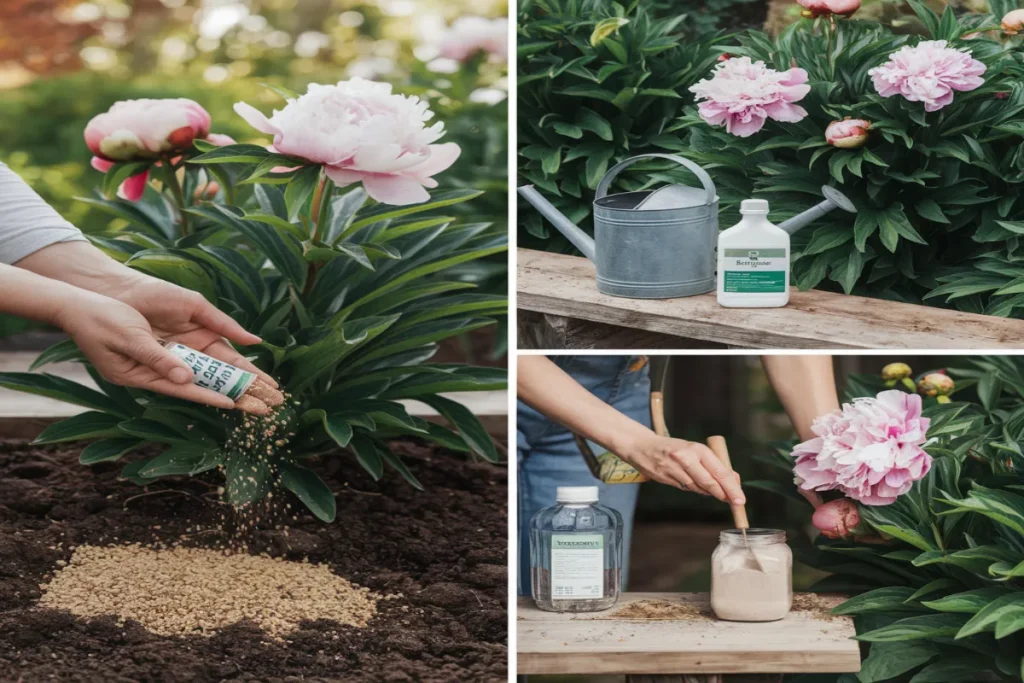My grandmother’s garden was a sanctuary of blooming peonies. They turned her backyard into a vibrant canvas of colors every spring. She always said the secret was understanding what these remarkable plants truly need.
Fertilizing peonies isn’t just about dumping nutrients—it’s about nurturing their unique growth requirements.
Peonies are long-lived perennials that reward gardeners with stunning blooms when treated with precision. Selecting the best fertiliser for peonies requires understanding their specific nutritional needs. While these plants are relatively low-maintenance, strategic fertilization can dramatically enhance their health and flowering.
The right fertilizer for peonies isn’t a one-size-fits-all solution. Different varieties—herbaceous and tree peonies—have unique nutrient requirements. A balanced approach focusing on phosphorus and potassium, instead of high nitrogen, will encourage robust flowering and strong root development.
Gardeners seeking lush, abundant peony blooms must recognize that timing and composition are key. Recommended fertilizer ratios like 5-10-10 or 10-20-20 provide the optimal nutrient balance. This supports these magnificent plants through their growth cycles, ensuring spectacular displays year after year.
Table of Contents
Understanding Peony Nutritional Needs
Peonies are amazing plants that need the right nutrients to grow well. With 32 species, knowing what they need is key for gardeners. This ensures their blooms are vibrant and healthy.
To grow peonies successfully, you must give them the right nutrients. These plants do best when they get the nutrients they need. Understanding their soil needs is also important.
Essential Nutrients for Healthy Peonies
Peonies need a mix of nutrients, often in the NPK ratio of 4-2-7. This mix helps them grow and bloom well. The main nutrients they need are:
- Nitrogen: Helps leaves and stems grow
- Phosphorus: Important for strong roots and blooms
- Potassium: Keeps the plant strong
| Nutrient | Function | Recommended Application |
|---|---|---|
| Nitrogen | Leaf growth | 80-120 g/m² in spring |
| Phosphorus | Root development | 100-150 g/m² during initial planting |
| Potassium | Plant strength | Slow-release fertilizer application |
Signs of Nutrient Deficiency
Spotting nutrient deficiencies early is important. It helps prevent damage to your peonies. Look out for these signs:
- Yellowing leaves: Often means they need more nitrogen
- Weak stems: Could be a sign of phosphorus lack
- Less flowering: May indicate potassium issues
Soil Requirements for Peonies
Peonies like soil that’s slightly acidic, with a pH of 6.5 to 7.5. The right soil helps them absorb nutrients well. Adding organic matter and ensuring good drainage are key to a great growing spot for these flowers.
Proper fertilization is the secret to peonies that can bloom beautifully for over 100 years!
Types of Fertilizer for Peonies

Choosing the right fertilizer for peonies is key to a successful garden. There are many options, each with its own benefits and how to use them.
Organic vs. Synthetic Fertilizers
Peony food falls into two main types: organic and synthetic. Organic fertilizers release nutrients slowly, improving soil health over time. Synthetic fertilizers, on the other hand, provide quick nutrient absorption.
- Organic fertilizers improve long-term soil health
- Synthetic fertilizers provide quick nutrient uptake
- Organic options reduce chemical dependency
Granular Fertilizers for Peonies
Most gardeners prefer slow-release granular fertilizers. These fertilizers release nutrients gradually, preventing damage to roots and supporting steady growth.
| Fertilizer Type | Nutrient Release | Application Frequency |
|---|---|---|
| Organic Granular | Slow | Once per season |
| Synthetic Granular | Moderate | Twice per season |
Liquid Fertilizers: When and How to Use
Water-soluble fertilizers are great for flexible use. They allow for targeted nutrient delivery, which is helpful during important growth periods.
*Pro tip: Apply liquid fertilizers when soil temperature reaches 50°F in early spring.*
To keep peonies healthy, pick fertilizers with a balanced NPK ratio. Focus on phosphorus for better blooming. Always follow the instructions and avoid over-fertilizing.
When to Fertilize Peonies
Timing is key when fertilizing peonies. Knowing when to fertilize is important for their health and blooms. The right fertilizer can make a big difference.
Timing for Spring Fertilization
Early spring is the best time to fertilize peonies. Wait until new growth is 12-16 inches tall. This is when they need the most nutrients.
- Apply fertilizer when shoots are 12-16 inches high
- Use a balanced fertilizer with NPK ratios of 3-4-5 or 3-5-5
- Spread approximately ¼ cup of granular organic fertilizer per plant
Importance of Fall Fertilization
Fertilizing in the fall helps peonies get ready for the next year. It supports root growth and helps them store nutrients.
- Apply half the annual fertilizer amount after cutting back dormant plants
- Use organic fertilizers to prevent root burn
- Maintain soil pH between 6.5 and 7 for optimal nutrient absorption
Considering Peony Varieties
Each type of peony needs a bit different care. Herbaceous peonies and tree peonies have different needs.
| Peony Type | Annual Fertilizer Amount |
|---|---|
| Herbaceous Peonies | ¼ cup |
| Tree Peonies | ½ cup |
| Young Peonies (under 2 years) | 2 tablespoons |
“Proper fertilization is the key to stunning peony blooms and robust plant health.” – Expert Gardening Advice
Always test your soil before fertilizing. Apply nutrients 8-18 inches away from the plant to avoid burn.
How to Apply Fertilizer to Peonies
Proper fertilization is key for growing vibrant and healthy peonies. Knowing the right techniques helps gardeners get the most from their plants. This leads to stunning floral displays.
Best Practices for Fertilizer Application
Here are the essential steps for applying fertilizer to peonies:
- Keep granular fertilizer 3-4 inches away from plant stems
- Scratch fertilizer into soil to a depth of 1-2 inches
- Use a balanced fertilizer with lower nitrogen content
- Apply approximately ¼ cup for herbaceous peonies
Avoiding Common Mistakes
Creating a homemade fertilizer for peonies needs careful attention. Gardeners should avoid these common errors:
- Applying fertilizer directly to plant crown
- Using excessive nitrogen-rich fertilizers
- Over-fertilizing mature plants
- Neglecting soil pH testing
Watering After Fertilization
Proper watering is critical after applying fertilizer. Thoroughly water the area to help distribute nutrients and prevent fertilizer burn. Keep the soil moist but not waterlogged.
Pro Tip: Water deeply but infrequently to encourage strong root development and optimize nutrient absorption.
By following these guidelines, gardeners can ensure their peonies get the best nutrition. This leads to robust growth and spectacular blooming.
Fertilizing Peonies in Different Soil Types
Knowing your soil is key to growing great peonies. Each soil type needs its own fertilizing plan. This ensures your peonies grow strong and bloom beautifully.
Sandy Soil Fertilization Strategies
Sandy soils are tricky for peonies. They drain fast and need careful nutrient care. Bone meal is perfect for sandy soils, helping roots grow.
- Add organic matter to improve soil structure
- Use slow-release peony fertilizer bone meal
- Apply fertilizer more frequently due to rapid nutrient leaching
Clay Soil Fertilization Techniques
Clay soils hold nutrients well but can be hard on roots. The right fertilizing helps keep the soil healthy and supports peony growth.
| Soil Characteristic | Fertilization Recommendation |
|---|---|
| Nutrient Retention | Use less frequent, concentrated applications |
| Drainage | Add organic matter to improve soil structure |
| pH Level | Maintain between 6.5-7.0 for optimal nutrient absorption |
Loamy Soil Considerations
Loamy soil is the best for peonies. It’s rich in organic matter and well-balanced. This soil is perfect for nutrient absorption and root growth.
“Loamy soil is the gardener’s gold standard for growing healthy, vibrant peonies.” – Professional Gardening Expert
Choosing the right fertilizer depends on your soil type. Bone meal is a natural, phosphorus-rich option. It supports strong roots in many soil conditions.
Benefits of Using Organic Fertilizers
Organic fertilizers are great for feeding peony plants and keeping soil healthy. They offer many benefits beyond just giving plants nutrients.
Improved Soil Health
Organic fertilizers improve soil structure and boost microbial activity. They create a healthy environment for peonies to grow by:
- Enhancing soil tilth and drainage
- Stimulating beneficial microorganism populations
- Gradually releasing nutrients throughout the growing season
Environmental Impact
Using organic fertilizers helps gardeners care for the environment. Environmentally conscious gardeners know that these fertilizers:
- Reduce chemical runoff
- Lower carbon footprint
- Support natural ecosystem balance
Enhancing Flower Quality
Organic fertilizers make peony blooms better. Studies show that well-fed peonies have stronger roots, leading to:
- More vibrant and abundant flowers
- Increased disease resistance
- Longer-lasting blooms
*Healthy soil is the foundation of spectacular peony displays.*
Choosing organic fertilizers means better plant health and caring for the environment. This ensures beautiful peony gardens for many years.

Potential Risks of Over-Fertilization
Gardeners who love peonies need to know about the right amount of fertilizer. Too much can hurt your flowers. It’s important to get the fertilization just right to keep your plants healthy.
Too much fertilizer is a big problem for growing peonies. About 40% of gardeners accidentally use too much, which can really harm the plants.
Identifying Over-Fertilization Symptoms
Spotting over-fertilization early is key to keeping peonies healthy. Look out for these signs:
- Too much leaf growth with few flowers
- Leaf edges that are burned or discolored
- Stunted roots
- More problems with pests and diseases
Long-term Effects on Peonies
Too much fertilizer can cause lasting harm. Too much nitrogen can cut flower production by 25%. It also messes up the soil’s balance, leading to more nutrient loss.
Correcting Over-Fertilization Issues
Is bone meal good for peonies? Yes, when used right, it’s a great organic choice. To fix over-fertilization:
- Stop adding fertilizer right away
- Flush the soil with water to get rid of extra nutrients
- Get a soil test to see what’s in the soil
- Use organic stuff like bone meal carefully
Pro tip: 60% of damage from too much fertilizer can be fixed if you catch it early. Watch your plants closely and fertilize wisely to keep them healthy and blooming.
Frequently Asked Questions
What is the best fertilizer for peonies?
Peonies thrive with a low-nitrogen, balanced fertilizer like 10-10-10 or 5-10-10. A phosphorus-rich fertilizer (higher middle number) can help promote strong blooms.
What feed is best for peonies?
A slow-release, granular fertilizer is best. Look for formulas with bone meal, compost, or well-balanced nutrients. Organic options like fish emulsion or aged manure also work well.
What food is good for peonies?
Peonies love a mix of:
Bone meal – Boosts root strength and flower production.
Compost or aged manure – Provides natural nutrients.
10-10-10 or 5-10-10 fertilizer – Balanced feeding without excessive nitrogen.
Is Miracle-Gro good for peonies?
Miracle-Gro can be used, but it’s not the best option. It has higher nitrogen, which can lead to more leaves and fewer flowers. If you use it, choose Miracle-Gro Bloom Booster or mix it with bone meal to balance nutrients.
What makes peonies bloom more?
To encourage more blooms:
Use a phosphorus-rich fertilizer in early spring.
Plant in full sun (at least 6 hours daily).
Water deeply but avoid overwatering (peonies hate soggy roots).
Deadhead spent flowers to redirect energy to the plant.
Avoid planting too deep—the eyes should be just below the soil surface.
What can you use 10-10-10 fertilizer on?
10-10-10 is a versatile, all-purpose fertilizer used for:
Peonies, roses, and flowering plants
Vegetables like tomatoes and peppers
Shrubs, trees, and lawns
Fruit trees and berry bushes

